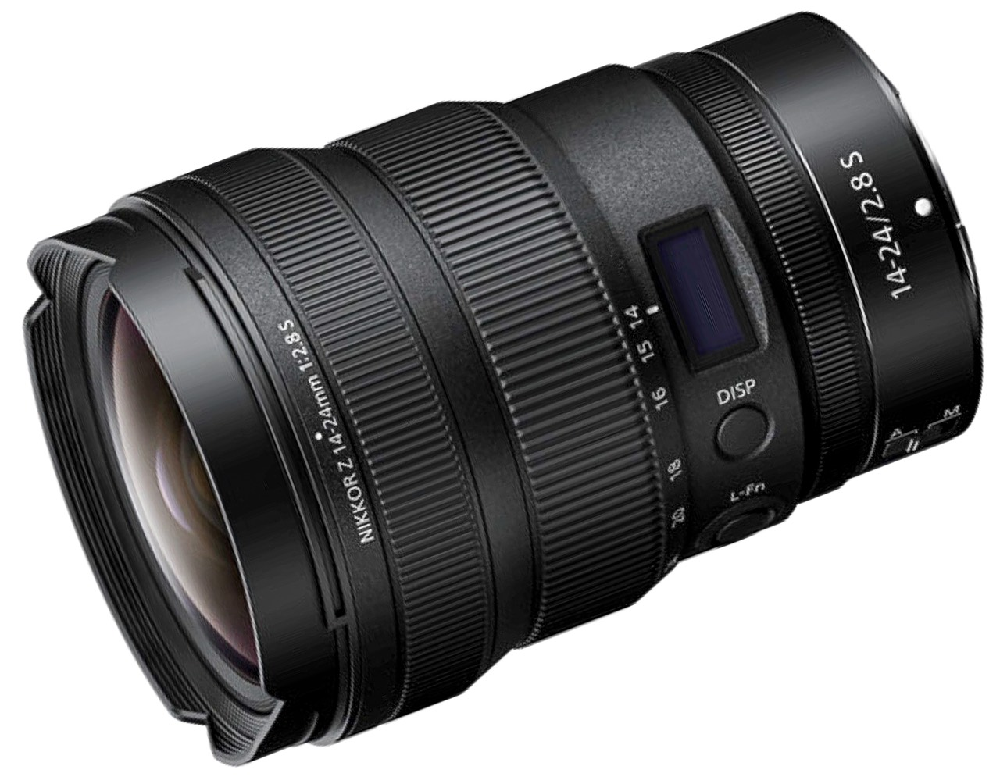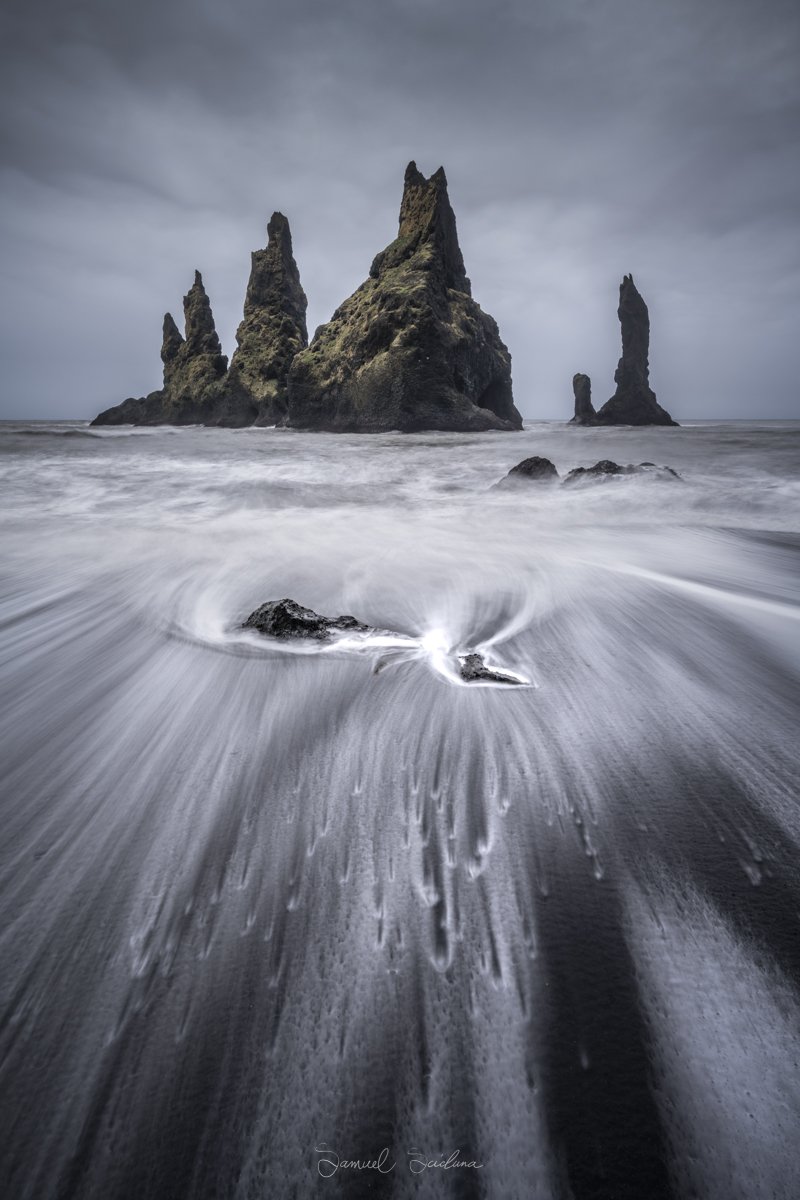Image courtesy of Nikon
Nikon's Nikkor Z 14-24mm F2.8 S is the lightweight and more compact successor to Nikon’s incredibly popular Nikkor AF-S 14-24mm F2.8G ED from way back in 2007. The new lens is optically superior and can be used with a 100mm filter system, this is a game-changer!
With a focal range of 14-24mm on full-frame bodies or 21-36mm on APS-C bodies, it is an ultra-wide-angle lens and is perfect for Landscapes, Architecture, and Astrophotography.
The Nikkor Z 14-24mm F2.8 S was announced in October 2020, and with most other products launched during Covid, there were significant delays in getting the items to consumers. I ordered this lens in November 2020 and it arrived in January 2021.
The new lens is just 10mm (0.3") narrower, but at 650g (1.44lb), it is 350g (0.78Lb) lighter. To use the original lens on a Nikon mirrorless camera would also require the use of an FTZ adapter, meaning an additional 31mm (1.2") in length and 135g (4.8oz) in weight. This makes the new Nikkor Z 14-24mm F2.8 S a much better lens for expeditions and hikes, where every gram counts.
The only other ultra-wide-angle lens that is an option is the Nikon 14-30mm F4 Lens. This is something I considered, as it is much lighter and even more compact than the Nikkor Z 14-24mm F2.8 S. The only downside of the 14-30mm lens is that it is not really any use for Astrophotography, which would mean that for any trips, I would need to carry the 14-30mm F4, the Samyang 14mm F2.8 and an FTZ Adaptor, which collectively weigh significantly more than the Nikkor Z 14-24mm F2.8 S and take up double the amount of space in my camera bag.
Key specifications:
Focal length: 14-24mm on Full Frame (21-36mm with APS-C crop)
Aperture range: F2.8 - F22
Stabilization: No
Filter thread: 112mm (with included HB-97 lens hood)
Close focus: 0.28m (11.0")
Maximum magnification: 0.13x
Diaphragm blades: 9
Hood: HB-96 and HB-97 hoods included
Weight: 650g (1.43 lb)
Optical construction: 16 elements in 11 groups (3 aspherical, 4 ED)
Handling and Build Quality
The Nikkor Z 14-24mm F2.8 S is slightly front-heavy on the Nikon Z7II and Nikon Z6II bodies, however, it is perfectly balanced on the Nikon Z9. Although Nikon has managed to make this lens smaller and lighter than its predecessor, it is still not a ‘Tiny’ or ‘Compact’ lens, but it is well-balanced and comfortable to use both handheld and also on a tripod.
The Nikkor Z 14-24mm F2.8 S is very well-built, with a solid, quality feel despite a predominantly plastic external shell.
Image courtesy of Nikon
This lens is a professional lens, meaning Nikon has treated it to a full suite of weather sealing (Dust and moisture), not just at the mount or front element, but around each button, ring, and switch too. I have put this to the test several times whilst storm chasing or being caught out in a rain shower and it has stood up to all my abuse without issue.
The Nikkor Z 14-24mm F2.8 S has six controls in total, these are located along the barrel of the lens and in the form of a switch (Auto/Manual Focus), 2 buttons (Display and Customizable Function) and 3 rings (Focal Length, Focus, Control Ring).
All 6 of these control feel like they are made to last and just scream quality. All three rings turn smoothly, with both the manual focus ring and control ring being nicely dampened. This lens has Nikon’s new ‘Control Ring’, which can be set to control the aperture, ISO or exposure compensation. I have mine set to control the aperture, although I don’t actually use this control ring to change the aperture, instead I use the thumb wheel.
The Nikkor Z 14-24mm F2.8 S does not have any image stabilization built in, but this is expected for such a wide-angle lens. This isn’t really an issue either, as all Nikon’s prosumer-grade mirrorless bodies have in-body image stabilization.
As with many of Nikon’s new S-Line lenses, there is a small OLED information display on the Nikkor Z 14-24mm F2.8 S. This is located between the zoom and control rings. The customizable function button is another configurable control that can be set through the camera's menu system to options including autofocus lock, subject tracking, image playback, and more. The Display button cycles through three different display modes: focal length, aperture, or focus distance.
Nikon’s fluorine coating repels water, dust, and dirt without compromising image quality. It also allows the front element of the lens to be cleaned more easily.
The front lens element is fluorine-coated. Nikon’s fluorine coating repels water, dust, and dirt without compromising image quality. It also allows the front element of the lens to be cleaned more easily. It's also flat, which is a major contrast to the large, bulging front elements of the earlier DSLR wide-angle lenses. As a result of this less-bulbous front element, filter manufacturers like Haida have been able to create bespoke adaptor rings which allow this lens to be used with 100mm filters.
This is an absolute game changer, as previously 14mm lenses required much bigger, heavier, and more expensive 150mm filter systems. The Haida
Haida Nikon Z 14-24mm F2.8 adaptor ring allows the use of their hugely popular M10 Filter system.
The Nikkor Z 14-24mm F2.8 S comes with 2 different lens hoods, each has a different intended use.
HB-96 lens hood is the smaller of the two and is compatible with the standard lens cap. The HB-97 lens hood is much bulkier, especially when using its huge lens cap, this lens hood is intended for use with filters as it has a 112mm filter thread built into it. Both Nikon and B+W make filters in this size, however, these are bulky and expensive, Haida’s solution is much better, especially for anyone who already has 100mm filters.
The Nikon Z7II with the Nikon 14-24 F2.8 S and the Haida M10 Filter system
As with many bigger lenses, Nikon has also designed the 14-24mm F2.8 S to accept rear filters. Rear filters are tiny, reasonably priced and weigh almost nothing, however, they are fiddly to change, especially in the field. Haida also produces a rear filter kit for the Nikon 14-24mm F2.8 S, it includes a special holder, a screwdriver, and 4 different Neutral Density filters.
Focus
The lens uses an internal focusing stepper motor and features a minimum focus distance of 11 inches (28 centimeters) which I found allows for incredibly quiet, fast, and accurate focusing. That being said, I have only really used Autofocus to test it as part of this review, I always focus manually, mostly because I focus stack most of my images, but also because I only work on a tripod and I want to be absolutely certain that focus is spot on each and every time.
The Nikkor Z 14-24mm F2.8 S has a minimum focusing distance of 28cm (11"), this is ideal for getting close to an interesting foreground to add interest to the composition. Being this close to the foreground means that focus stacking is required.
Image quality
The Nikkor Z 14-24mm F2.8 S produces stunning images with minimal vignette and very little fringing, ghosting, or aberrations. Image quality and sharpness are without a doubt the greatest areas of strength for this lens.
I haven’t bothered with any sort of testing, the proof of the image quality of this lens is in the images it produces, so I will let a few of my favorite images show the quality of this fantastic piece of glass.
Sharpness
At 14mm center sharpness is excellent, even wide open at its maximum aperture of F2.8, there's no noticeable improvement in sharpness from stopping down.
Sharpness does drop off slightly as you approach the edges of the frame, such that details in these areas a little soft. Focusing on the corners sharpens them back up, indicating a degree of field curvature. Luckily, stopping down to F8 gives superb sharpness across the frame.
At 24mm, center sharpness is also excellent wide-open at F2.8, and there's only an extremely slight improvement from stopping down to F5.6. The extreme corners are a little soft, albeit less so than they were wide-open at 14mm, but again, both focusing in the corners and stopping down to F8 gives fantastic results.
Flare and Sunstars
Flare is controlled very well on the Nikkor Z 14-24mm F2.8 S due to the numerous special coatings on the various elements. The Lens hoods can also be used to shade the lens and avoid lens flares.
The Nikkor Z 14-24mm F2.8 S gives stunning sun stars thanks to its 9-blade diaphragm.
Pros
Lightweight and compact compared to other ultra-wide F2.8 lenses
Comprehensive weather-sealing throughout
Very sharp and free of most optical aberrations
Ability to use 100mm Filters
Gorgeous Sun Stars
Good contrast with minimal flaring
Shooting the Milky way with the Nikon 14-24 F2.8 S on a star tracker
Cons
Wide open sharpness drops off slightly toward the corners
This lens is not cheap (But totally worth it!)
Slightly front heavy on the Nikon Z7II / Z6II
Is it better than its Predecessor?
Yes, it surpasses the original Nikon Nikkor AF-S 14-24mm F2.8G ED in every aspect.
Verdict
For a lens of this type (Ultra-wide-angle and wide aperture), it's relatively compact and lightweight, produces stunning results and is a relatively aberration-free lens. Taking all this into account, it is easy to forget the few minor shortcomings of this lens, such as the slightly soft corners wide open and its relatively high price tag.
The Nikon Z 14-24mm f/2.8 S lens is one of the best lenses in the Nikon mirrorless lineup by miles and delivers top-tier ultra-wide-angle image quality in a lightweight body with great build quality and weather sealing.
While it doesn’t have the same range as the cheaper Nikon 14-30mm f/4 lens, it does give a full additional stop of light, which is absolutely necessary for capturing the Milkyway or the Northern Lights.
Should you buy It?
Yes. For anyone that regularly shoots landscape, architecture, and astrophotography, the compact size, ability to use 100mm filters, a fast aperture of F2.8, and sharpness of this lens make it a must-have for the serious landscape photographer.




















